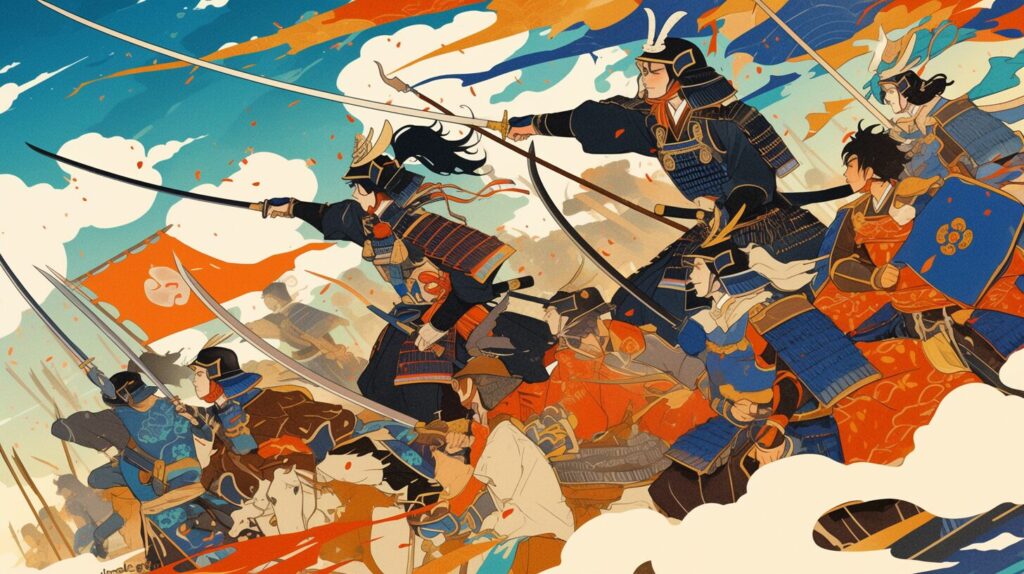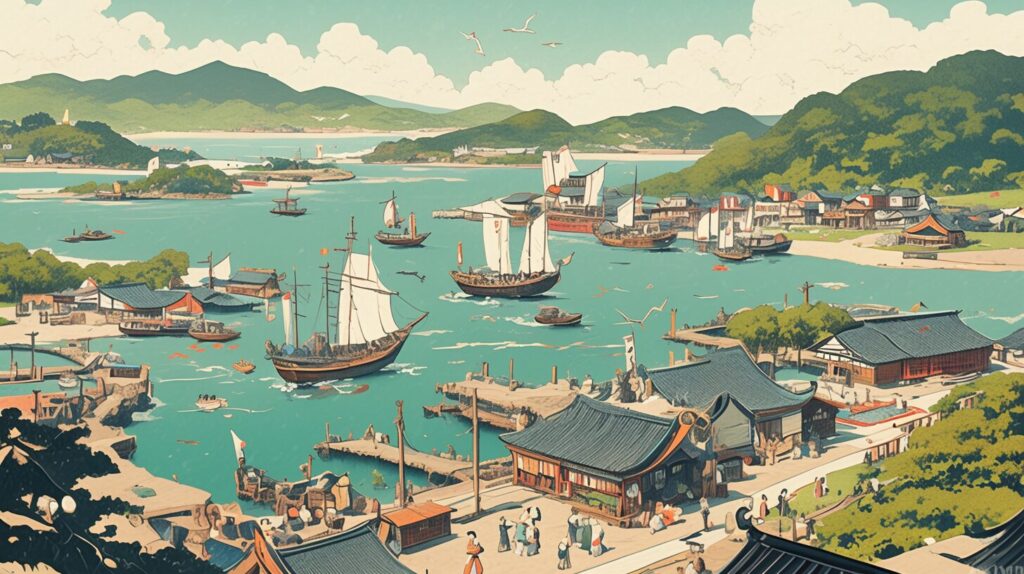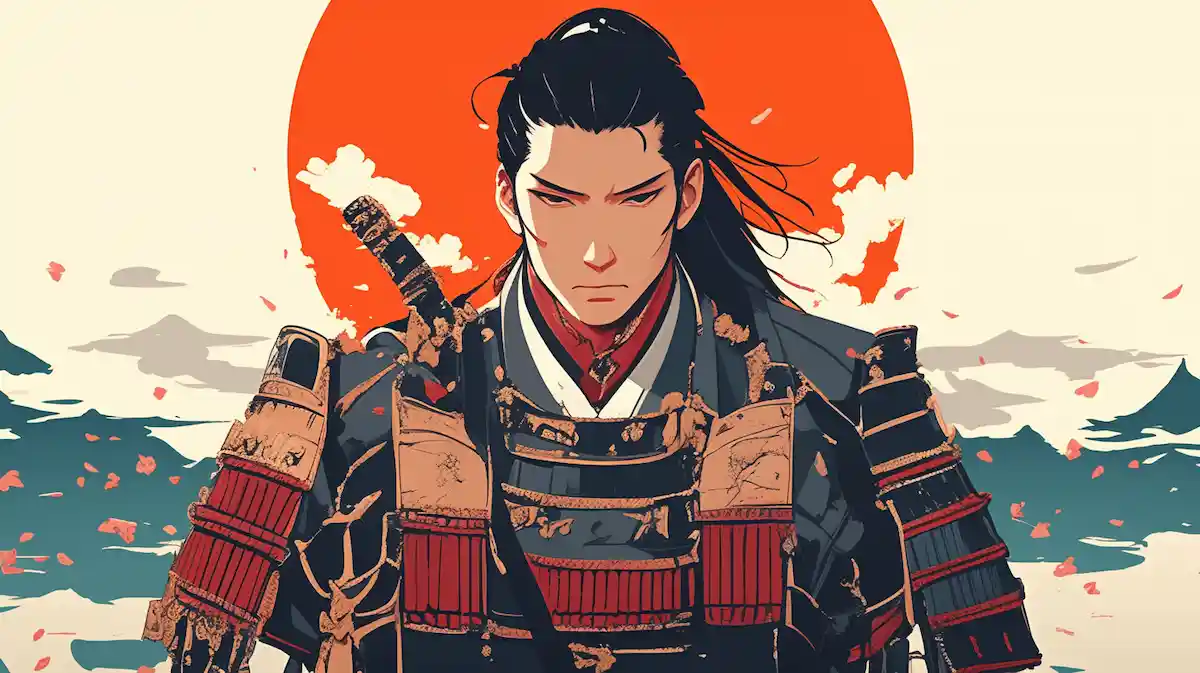平清盛を英語で説明・紹介するための基本情報と、英会話に役立つ表現をシンプルでわかりやすい英語で紹介します。
英会話ダイアローグ・概要・10の質問を通して、平清盛に関する英語表現を学びます。
英語
英会話ダイアローグを読む前に知っておくと良い前提知識と情報です。
- 平清盛とは?
- 平清盛(1118年-1181年)は平安時代末期の武将・政治家
- 平氏の棟梁として日本初の武家政権を樹立した
- 「平家にあらずんば人にあらず」と言われるほどの全盛期を築いた
- 歴史的背景
- 平安時代末期(12世紀)は貴族政治から武家政治への転換期
- それまでは藤原氏を中心とした公家(貴族)が政治を担っていた
- 武士は元々は貴族に仕える武装集団だった
- 平清盛の政治的功績
- 保元の乱(1156年)・平治の乱(1159年)で源氏に勝利
- 1167年、武士として初めて太政大臣に就任
- 後白河法皇の院政を停止させ、平氏による独裁体制を確立
- 経済・文化面での貢献
- 日宋貿易(中国の宋との貿易)を積極的に推進
- 大輪田泊(現在の神戸港)を整備
- 厳島神社(宮島)を崇敬し、社殿を造営
- 福原遷都
- 1180年、清盛は京都から神戸(福原京)へ遷都しようとした
- しかし、貴族たちの反対が強く、わずか6か月で元の京都に戻ることになった
- 平家の滅亡
- 1180年、源頼朝らによる源平合戦が始まる
- 1181年、平清盛は病で死去
- 1185年、壇ノ浦の戦いで平家は滅亡
- 清盛ゆかりの地
- 厳島神社(広島) – 清盛が保護し、発展させた神社、世界遺産
- 福原京跡(神戸) – 一時的に遷都を試みた場所
- 大輪田泊(神戸港) – 貿易拠点として発展させた港
- 壇ノ浦(山口・下関) – 平氏が滅亡した戦場跡
2人が平清盛について話しています。
平清盛の政治的功績、日宋貿易の推進、厳島神社との関わり、後白河法皇との対立、平家の滅亡などを話題にしています。
会話 / dialogue

Hey, Key. I’ve been really into Japanese history lately, and I’m fascinated by Taira no Kiyomori.

Nice! He’s one of the most important figures in samurai history. What got you interested?

Well, I visited Itsukushima Shrine in Hiroshima last month. I learned Kiyomori had a strong connection to it, but I didn’t know much about him.

Yeah! He didn’t rebuild the shrine, but he protected and expanded it. He was a strong believer in Itsukushima’s deity and helped make it an important religious center.

That’s interesting. But wasn’t he also the first samurai to control the government?

Exactly! Before Kiyomori, samurai were just fighters working for aristocrats. He paved the way for samurai to have political power.

So how did he get so powerful?

He won two major wars—the Hōgen War (1156) and the Heiji War (1159)—defeating the Minamoto clan. After that, his Taira clan became the most powerful in Japan.

I see. And after that, he took control of the government?

Yes. In 1167, he became Grand Minister (Daijō Daijin)—the highest government position. No samurai had ever reached that level before.

That must have changed a lot. But did he do anything other than fighting?

Absolutely! He expanded trade with China (Song Dynasty) and developed Ōwada no Tomari (modern Kobe Port) to support international trade.

Oh! So he helped Japan’s economy, too.

Exactly! He also introduced Chinese coins (Song coins) into Japan, which helped the economy grow.

I also heard he tried to move the capital. Is that true?

Yes! In 1180, he attempted to move the capital to Fukuhara (now part of Kobe). He wanted a capital closer to trade routes, but the nobles strongly opposed it.

So the move didn’t last?

No. Just six months later, they returned to Kyoto.

But I read that Emperor Go-Shirakawa wasn’t a fan of Kiyomori. What happened between them?

Ah, their relationship was complicated. At first, Kiyomori helped Go-Shirakawa win the throne in the Hōgen War. But later, the emperor didn’t like how much power Kiyomori had.

So they became enemies?

Yes. In 1179, Kiyomori arrested Go-Shirakawa and put him under house arrest. That made a lot of people angry and led to more conflicts.

That must have made the Minamoto clan even more determined to fight him.

Exactly! In 1180, Minamoto no Yoritomo started a rebellion against Kiyomori. The war continued even after Kiyomori died of illness in 1181.

And in 1185, the Minamoto finally defeated the Taira at Dannoura, right?

Yes. That was the end of the Taira clan. After that, Go-Shirakawa supported the Minamoto, and samurai rule became even stronger.

Wow, that’s such a dramatic story. So, how do people see Kiyomori today?

Some respect him as a great leader who helped create samurai rule. Others say he was too arrogant, which led to his downfall. He’s often seen as a tragic figure in The Tale of the Heike.

Either way, he completely changed Japan. I’d love to visit more places connected to him!

You definitely should! Kobe, Shimonoseki, and Kyoto all have sites related to him.
概要 / Overview
「平清盛」について、理解を深めるための「英語での概要」です。
平清盛

Who Was Taira no Kiyomori?
Taira no Kiyomori (1118–1181) was a powerful samurai leader in Japan’s late Heian period. He was the first samurai to gain political control and helped change Japan from a noble-led society to a warrior-led one. His leadership prepared the way for the future samurai governments like the Kamakura Shogunate.
Winning Important Battles
Kiyomori became powerful after winning two major battles: the Hōgen War (1156) and the Heiji War (1159). In these battles, he defeated the Minamoto clan (Genji) and made his Taira clan (Heike) the most powerful in Japan. After his victory, he became a top government official and ruled the country.
Economic and Trade Development
Kiyomori expanded trade with China (Song Dynasty), which made Japan’s economy stronger. He developed the port of Ōwada no Tomari (modern Kobe) for international trade. He also introduced Chinese coins (Song coins) into Japan, which helped the economy grow.
Conflict with Emperor Go-Shirakawa
At first, Kiyomori helped Emperor Go-Shirakawa become ruler. However, as Kiyomori’s power grew, the emperor saw him as a threat. In 1179, Kiyomori arrested Go-Shirakawa and took complete control. This made many enemies, including the Minamoto clan.
The Fall of the Taira Clan
In 1180, Minamoto no Yoritomo started a war against Kiyomori. Although Kiyomori died of illness in 1181, the war continued. In 1185, the Minamoto defeated the Taira at the Battle of Dannoura, and the Taira clan was destroyed.
Kiyomori’s Legacy
Taira no Kiyomori was a strong but controversial leader. Some respect him for helping samurai gain power and growing Japan’s economy, while others say he was too arrogant. He remains an important figure in Japanese history.
10の質問 / 10 questions
「平清盛」について、理解を深めるための「英語での10の質問」です。
1: Who was Taira no Kiyomori?
Taira no Kiyomori was a powerful samurai leader in the late Heian period. He was the first samurai to gain political power and helped change Japan from a noble-led society to a warrior-led one.
2: What were the major battles that made Kiyomori powerful?
Kiyomori won the Hōgen War (1156) and the Heiji War (1159). These victories helped the Taira clan become the most powerful in Japan, defeating the Minamoto clan.
3: What government position did Kiyomori achieve?
In 1167, Kiyomori became Grand Minister (Daijō Daijin), the highest political position at the time. He was the first samurai to reach such a high rank in the imperial court.
4: How did Kiyomori contribute to Japan’s economy?
He expanded trade with China (Song Dynasty) and developed Ōwada no Tomari (modern Kobe Port). He also introduced Chinese coins (Song coins) to Japan, strengthening the economy.
5: What was Kiyomori’s connection to Itsukushima Shrine?
Kiyomori strongly believed in the deity of Itsukushima Shrine. He protected and expanded the shrine, making it an important religious and cultural site.
6: Why did Kiyomori and Emperor Go-Shirakawa become enemies?
At first, Kiyomori supported Emperor Go-Shirakawa, but later, the emperor saw him as too powerful. In 1179, Kiyomori put the emperor under house arrest, which made many nobles and samurai turn against him.
7: Did Kiyomori try to move the capital?
Yes, in 1180, Kiyomori moved the capital to Fukuhara (now part of Kobe). However, strong opposition forced him to return the capital to Kyoto after only six months.
8: How did Kiyomori’s rule lead to the downfall of the Taira clan?
Kiyomori’s strong control over politics and his enemies’ anger led to war. In 1180, Minamoto no Yoritomo started a rebellion, and after Kiyomori died in 1181, the war continued.
9: What happened at the Battle of Dannoura?
In 1185, the Minamoto clan defeated the Taira clan at the Battle of Dannoura. Many Taira warriors, including Emperor Antoku, drowned, and the Taira clan was destroyed.
10: How is Taira no Kiyomori remembered today?
Some people respect him as a great leader who helped samurai gain power, while others see him as too arrogant. He is often viewed as a tragic figure in The Tale of the Heike.

和訳付
会話 / dialogue

Hey, Key. I’ve been really into Japanese history lately, and I’m fascinated by Taira no Kiyomori.
ねえ、キー。最近、日本の歴史にハマってるんだけど、平清盛にすごく興味があるんだ。

Nice! He’s one of the most important figures in samurai history. What got you interested?
いいね!彼は侍の歴史の中でも最も重要な人物の一人だよ。何がきっかけで興味を持ったの?

Well, I visited Itsukushima Shrine in Hiroshima last month. I learned Kiyomori had a strong connection to it, but I didn’t know much about him.
先月、広島の厳島神社に行ったんだ。そこで清盛と深い関係があるって知ったんだけど、彼についてはあまり知らなかったんだよね。

Yeah! He didn’t rebuild the shrine, but he protected and expanded it. He was a strong believer in Itsukushima’s deity and helped make it an important religious center.
そう!清盛は神社を「再建」したわけじゃないけど、庇護して発展させたんだ。厳島神社の神を深く信仰していて、神社を重要な宗教的な場所に育てたんだよ。

That’s interesting. But wasn’t he also the first samurai to control the government?
それは面白いね。でも、彼は日本で初めて政治を支配した武士だったんじゃない?

Exactly! Before Kiyomori, samurai were just fighters working for aristocrats. He paved the way for samurai to have political power.
その通り!清盛の前は、武士はただ貴族に仕える戦士に過ぎなかった。でも、彼が武士が政治に進出する道を切り開いたんだ。

So how did he get so powerful?
じゃあ、どうやってそんなに力を持つようになったの?

He won two major wars—the Hōgen War (1156) and the Heiji War (1159)—defeating the Minamoto clan. After that, his Taira clan became the most powerful in Japan.
彼は保元の乱(1156年)と平治の乱(1159年)という二つの大きな戦いで勝利して、源氏を打ち破ったんだ。その後、平氏は日本で最も強い一族になった。

I see. And after that, he took control of the government?
なるほど。それで政治を掌握したの?

Yes. In 1167, he became Grand Minister (Daijō Daijin)—the highest government position. No samurai had ever reached that level before.
そう。1167年に太政大臣になったんだよ。これは武士として初めてのことで、これまでそんな地位に上がった侍はいなかったんだ。

That must have changed a lot. But did he do anything other than fighting?
それってすごく大きな変化だね。でも、戦うこと以外に何かやったの?

Absolutely! He expanded trade with China (Song Dynasty) and developed Ōwada no Tomari (modern Kobe Port) to support international trade.
もちろん!彼は宋(中国)との貿易を拡大し、大輪田泊(現在の神戸港)を発展させたんだ。貿易を通じて日本を豊かにしようとしたんだよ。

Oh! So he helped Japan’s economy, too.
へえ!つまり、日本の経済も発展させたんだね。

Exactly! He also introduced Chinese coins (Song coins) into Japan, which helped the economy grow.
その通り!それに、中国の宋銭を日本に流通させて、貨幣経済を発展させたんだよ。

I also heard he tried to move the capital. Is that true?
それから、都を移そうとしたって聞いたんだけど、本当?

Yes! In 1180, he attempted to move the capital to Fukuhara (now part of Kobe). He wanted a capital closer to trade routes, but the nobles strongly opposed it.
そう!1180年に福原(現在の神戸)に遷都を試みたんだ。貿易に便利な場所にしたかったんだけど、貴族たちの反対が強くてね。

So the move didn’t last?
じゃあ、結局うまくいかなかったんだ?

No. Just six months later, they returned to Kyoto.
うん。たった6か月で京都に戻ったよ。

But I read that Emperor Go-Shirakawa wasn’t a fan of Kiyomori. What happened between them?
でも、後白河法皇は清盛を嫌っていたって読んだけど、何があったの?

Ah, their relationship was complicated. At first, Kiyomori helped Go-Shirakawa win the throne in the Hōgen War. But later, the emperor didn’t like how much power Kiyomori had.
うーん、二人の関係は複雑だったよ。最初、保元の乱で清盛は後白河天皇を支援したんだけど、後になって天皇は清盛の権力が強すぎると嫌がったんだ。

So they became enemies?
じゃあ、結局敵になったの?

Yes. In 1179, Kiyomori arrested Go-Shirakawa and put him under house arrest. That made a lot of people angry and led to more conflicts.
そう。1179年に清盛は後白河法皇を幽閉しちゃったんだ。それで、多くの人の反感を買って、さらに対立が激しくなったんだよ。

That must have made the Minamoto clan even more determined to fight him.
それで、源氏はますます清盛と戦おうとしたんじゃない?

Exactly! In 1180, Minamoto no Yoritomo started a rebellion against Kiyomori. The war continued even after Kiyomori died of illness in 1181.
その通り!1180年に源頼朝が反乱を起こしたんだ。その戦いは、清盛が1181年に病死した後も続いたよ。

And in 1185, the Minamoto finally defeated the Taira at Dannoura, right?
それで、1185年に源氏が壇ノ浦の戦いで平氏を完全に倒したんだよね?

Yes. That was the end of the Taira clan. After that, Go-Shirakawa supported the Minamoto, and samurai rule became even stronger.
そう。これで平氏は滅亡した。その後、後白河法皇は源氏を支持して、武士の時代がさらに強まったんだ。

Wow, that’s such a dramatic story. So, how do people see Kiyomori today?
すごいドラマチックな話だね。でも、今の人たちは清盛のことをどう見てるの?

Some respect him as a great leader who helped create samurai rule. Others say he was too arrogant, which led to his downfall. He’s often seen as a tragic figure in The Tale of the Heike.
武士の時代を作るのに貢献した偉大なリーダーとして尊敬する人もいれば、傲慢すぎて滅亡を招いたと批判する人もいるよ。『平家物語』では、清盛は悲劇的な人物として描かれているんだ。

Either way, he completely changed Japan. I’d love to visit more places connected to him!
どっちにしても、日本を大きく変えた人だよね。清盛ゆかりの地をもっと巡ってみたいな!

You definitely should! Kobe, Shimonoseki, and Kyoto all have sites related to him.
絶対に行くべきだよ!神戸、下関、京都には清盛に関係する場所がたくさんあるからね。
概要 / Overview
平清盛

Who Was Taira no Kiyomori?
Taira no Kiyomori (1118–1181) was a powerful samurai leader in Japan’s late Heian period. He was the first samurai to gain political control and helped change Japan from a noble-led society to a warrior-led one. His leadership prepared the way for the future samurai governments like the Kamakura Shogunate.
平清盛とは誰か?
平清盛(1118年~1181年)は、平安時代の終わりに活躍した強力な武士のリーダーでした。彼は初めて政治の実権を握った武士で、それまで貴族が支配していた日本を、武士の時代へと変える役割を果たしました。彼の統治は、後の鎌倉幕府のような武士政権の基盤を築くことにつながりました。
Winning Important Battles
Kiyomori became powerful after winning two major battles: the Hōgen War (1156) and the Heiji War (1159). In these battles, he defeated the Minamoto clan (Genji) and made his Taira clan (Heike) the most powerful in Japan. After his victory, he became a top government official and ruled the country.
重要な戦いでの勝利
清盛は、保元の乱(1156年)と平治の乱(1159年)の二つの大きな戦いに勝利し、強大な力を手にしました。これらの戦いで、彼は源氏を打ち破り、平氏を日本で最も強い一族にしました。その後、彼は朝廷の高官となり、日本の政治を支配しました。
Economic and Trade Development
Kiyomori expanded trade with China (Song Dynasty), which made Japan’s economy stronger. He developed the port of Ōwada no Tomari (modern Kobe) for international trade. He also introduced Chinese coins (Song coins) into Japan, which helped the economy grow.
経済と貿易の発展
清盛は、中国(宋)との貿易を拡大し、日本の経済をより強くしました。彼は国際貿易のために大輪田泊(現在の神戸港)を整備し、日本を貿易の中心地にしようとしました。また、中国の貨幣(宋銭)を日本に流通させ、経済の発展に貢献しました。
Conflict with Emperor Go-Shirakawa
At first, Kiyomori helped Emperor Go-Shirakawa become ruler. However, as Kiyomori’s power grew, the emperor saw him as a threat. In 1179, Kiyomori arrested Go-Shirakawa and took complete control. This made many enemies, including the Minamoto clan.
後白河法皇との対立
最初、清盛は後白河天皇(のちに法皇)を支援し、即位を助けました。しかし、清盛の権力が強まるにつれて、後白河法皇は彼を脅威と見なすようになりました。そして1179年、清盛は後白河法皇を幽閉し、完全に政権を掌握しました。この行動は、多くの敵を作ることになり、特に源氏の反発を招きました。
The Fall of the Taira Clan
In 1180, Minamoto no Yoritomo started a war against Kiyomori. Although Kiyomori died of illness in 1181, the war continued. In 1185, the Minamoto defeated the Taira at the Battle of Dannoura, and the Taira clan was destroyed.
平氏の滅亡
1180年、源頼朝が清盛に対抗して挙兵しました。清盛は1181年に病死しましたが、戦いは続きました。そして1185年、壇ノ浦の戦いで源氏が平氏を完全に打ち破り、平家は滅亡しました。
Kiyomori’s Legacy
Taira no Kiyomori was a strong but controversial leader. Some respect him for helping samurai gain power and growing Japan’s economy, while others say he was too arrogant. He remains an important figure in Japanese history.
清盛の遺産(歴史的評価)
平清盛は、強くも賛否の分かれるリーダーでした。彼を「武士の時代を開いた偉大な存在」や「日本経済を発展させた人物」として評価する人もいれば、「権力を持ちすぎて傲慢だった」と批判する人もいます。しかし、彼が日本の歴史に与えた影響は大きく、今でも重要な歴史上の人物とされています。
10の質問 / 10 questions
1: Who was Taira no Kiyomori?
平清盛とは誰ですか?
Taira no Kiyomori was a powerful samurai leader in the late Heian period. He was the first samurai to gain political power and helped change Japan from a noble-led society to a warrior-led one.
平清盛は平安時代の終わりに活躍した強力な武士のリーダーでした。彼は初めて政治の実権を握った武士であり、日本を貴族中心の社会から武士が支配する社会へと変えるのに貢献しました。
2: What were the major battles that made Kiyomori powerful?
清盛が強大な力を持つようになった主要な戦いは何ですか?
Kiyomori won the Hōgen War (1156) and the Heiji War (1159). These victories helped the Taira clan become the most powerful in Japan, defeating the Minamoto clan.
清盛は保元の乱(1156年)と平治の乱(1159年)に勝利しました。これらの勝利により、平氏は日本で最も強い一族となり、源氏を打ち破りました。
3: What government position did Kiyomori achieve?
清盛はどのような政府の地位を得ましたか?
In 1167, Kiyomori became Grand Minister (Daijō Daijin), the highest political position at the time. He was the first samurai to reach such a high rank in the imperial court.
1167年に清盛は太政大臣に就任しました。当時の最高位の政治的地位であり、武士として初めてこのような高い地位に就いた人物でした。
4: How did Kiyomori contribute to Japan’s economy?
清盛は日本の経済にどのように貢献しましたか?
He expanded trade with China (Song Dynasty) and developed Ōwada no Tomari (modern Kobe Port). He also introduced Chinese coins (Song coins) to Japan, strengthening the economy.
彼は宋(中国)との貿易を拡大し、大輪田泊(現在の神戸港)を発展させました。また、宋銭(中国の貨幣)を日本に流通させ、経済を強化しました。
5: What was Kiyomori’s connection to Itsukushima Shrine?
清盛と厳島神社の関係は何ですか?
Kiyomori strongly believed in the deity of Itsukushima Shrine. He protected and expanded the shrine, making it an important religious and cultural site.
清盛は厳島神社の神を深く信仰していました。彼は神社を保護し、発展させ、日本の重要な宗教・文化の拠点としました。
6: Why did Kiyomori and Emperor Go-Shirakawa become enemies?
なぜ清盛と後白河法皇は敵対するようになったのですか?
At first, Kiyomori supported Emperor Go-Shirakawa, but later, the emperor saw him as too powerful. In 1179, Kiyomori put the emperor under house arrest, which made many nobles and samurai turn against him.
最初、清盛は後白河天皇を支援していましたが、後に天皇は清盛が権力を持ちすぎていると考えるようになりました。1179年に清盛は後白河法皇を幽閉し、多くの貴族や武士が彼に反対するようになりました。
7: Did Kiyomori try to move the capital?
清盛は都を移そうとしましたか?
Yes, in 1180, Kiyomori moved the capital to Fukuhara (now part of Kobe). However, strong opposition forced him to return the capital to Kyoto after only six months.
はい。1180年に清盛は福原(現在の神戸の一部)へ遷都を試みました。しかし、貴族たちの強い反対により、わずか6か月で京都に戻ることになりました。
8: How did Kiyomori’s rule lead to the downfall of the Taira clan?
清盛の統治はどのようにして平氏の滅亡につながりましたか?
Kiyomori’s strong control over politics and his enemies’ anger led to war. In 1180, Minamoto no Yoritomo started a rebellion, and after Kiyomori died in 1181, the war continued.
清盛の強引な政治支配と、それに対する敵の反発が戦争を引き起こしました。1180年に源頼朝が反乱を起こし、清盛が1181年に病死した後も戦いは続きました。
9: What happened at the Battle of Dannoura?
壇ノ浦の戦いでは何が起こりましたか?
In 1185, the Minamoto clan defeated the Taira clan at the Battle of Dannoura. Many Taira warriors, including Emperor Antoku, drowned, and the Taira clan was destroyed.
1185年の壇ノ浦の戦いで、源氏は平氏を打ち破りました。安徳天皇を含む多くの平氏の武士が海に沈み、平氏は滅亡しました。
10: How is Taira no Kiyomori remembered today?
今日、平清盛はどのように評価されていますか?
Some people respect him as a great leader who helped samurai gain power, while others see him as too arrogant. He is often viewed as a tragic figure in The Tale of the Heike.
彼を武士の時代を切り開いた偉大なリーダーとして評価する人もいれば、権力を持ちすぎた傲慢な人物と見る人もいます。彼はしばしば『平家物語』の中で悲劇的な人物として描かれています。

words & phrases
英会話ダイアローグと関連情報に出てきた単語・フレーズです(例文は各3つ)。

pave the way for : 句動詞
意味: ~への道を開く、準備をする。To make it possible for something to happen in the future.
(平清盛は武士が政治を支配する時代への道を開いた人物として使用)
例文:
- His efforts paved the way for future technological advancements.
「彼の努力が将来の技術革新の道を開いた。」 - The discovery of antibiotics paved the way for modern medicine.
「抗生物質の発見が現代医学の発展への道を開いた。」 - Taira no Kiyomori paved the way for the rise of samurai rule.
「平清盛は武士政権の台頭への道を開いた。」
defeat : 動詞
意味: ~を打ち負かす、敗北させる。To win against someone in a battle, game, or competition.
(平清盛は保元の乱と平治の乱で源氏を打ち負かしたことを表すために使用)
例文:
- The army defeated its enemies in the battle.
「その軍は戦いで敵を打ち負かした。」 - The team was defeated in the final match.
「そのチームは決勝戦で敗北した。」 - Minamoto no Yoritomo eventually defeated the Taira clan.
「源頼朝は最終的に平氏を打ち破った。」
take control : 句動詞
意味: ~を支配する、掌握する。To gain power or authority over something.
(平清盛が政治の実権を握ったことを説明するために使用)
例文:
- The new government took control of the country after the revolution.
「新政府は革命後に国の支配権を握った。」 - She took control of the project and led it to success.
「彼女はプロジェクトを掌握し、成功へ導いた。」 - Taira no Kiyomori took control of the imperial court in 1179.
「平清盛は1179年に朝廷の実権を握った。」
arrogant : 形容詞
意味: 傲慢な、横柄な。Having an attitude of superiority and behaving as if one is more important than others.
(平清盛の政治手法が一部の人々に「傲慢」と見られたことを説明するために使用)
例文:
- He was too arrogant to listen to anyone’s advice.
「彼はあまりにも傲慢で、誰の助言も聞こうとしなかった。」 - The arrogant leader refused to negotiate.
「その傲慢な指導者は交渉を拒否した。」 - Some people saw Kiyomori as an arrogant ruler.
「平清盛を傲慢な支配者と見る人もいた。」
downfall : 名詞
意味: 崩壊、失脚、没落。The loss of power, success, or status.
(平清盛の死後、平氏が壇ノ浦の戦いで滅亡したことを説明するために使用)
例文:
- The scandal led to the politician’s downfall.
「そのスキャンダルが政治家の失脚につながった。」 - Economic problems caused the downfall of the empire.
「経済問題がその帝国の崩壊を招いた。」 - The Battle of Dannoura marked the downfall of the Taira clan.
「壇ノ浦の戦いは平氏の滅亡を示した。」
